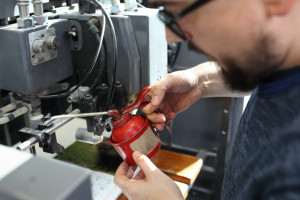 Maintenance is good. Maintenance is useful. But like all other tools, the wrong type of maintenance can cause more problems than it wants to solve. Hence, in this post I would like to point out some of the flaws of Total Productive Maintenance (TPM). Don’t get me wrong. TPM is useful and has its strengths, but it also has its weaknesses. You need to know both to use TPM properly. I am looking forward to your input in the comments, as I am sure I will learn something.
Maintenance is good. Maintenance is useful. But like all other tools, the wrong type of maintenance can cause more problems than it wants to solve. Hence, in this post I would like to point out some of the flaws of Total Productive Maintenance (TPM). Don’t get me wrong. TPM is useful and has its strengths, but it also has its weaknesses. You need to know both to use TPM properly. I am looking forward to your input in the comments, as I am sure I will learn something.
TPM
How to Do Reactive Maintenance
 In this post I will finally go into more details on reactive maintenance. I already explained in my last post that I am missing the reactive maintenance in the eight pillars of Total Productive Maintenance (TPM), as well as preventive maintenance being often the better approach. The goal of reactive maintenance is to resolve breakdowns quickly to minimize the delay. This often includes a spare-parts management to decide which spare parts to keep in stock and which ones to order. It also helps to get a better understanding of your system to know what you are more likely to need and what not. A good analogy is the fire department, where speed is also (or even more) critical. Let’s look at the details:
In this post I will finally go into more details on reactive maintenance. I already explained in my last post that I am missing the reactive maintenance in the eight pillars of Total Productive Maintenance (TPM), as well as preventive maintenance being often the better approach. The goal of reactive maintenance is to resolve breakdowns quickly to minimize the delay. This often includes a spare-parts management to decide which spare parts to keep in stock and which ones to order. It also helps to get a better understanding of your system to know what you are more likely to need and what not. A good analogy is the fire department, where speed is also (or even more) critical. Let’s look at the details:
The Pillars of TPM – The Missing Pillar Reactive Maintenance?

In the last few posts I went in detail through the eight pillars of Total Productive Maintenance (TPM). However, looking at this framework of eight pillars, besides having a few pillars too many, I am sorely missing one very important pillar: Reactive Maintenance! How do you fix stuff after it breaks? If I create a structured approach for maintenance, reactive maintenance would be one of the key points, yet it is completely absent in the TPM framework. This is in my opinion one of the flaws of TPM. I am looking forward to receiving your responses or rebuttals. I am sure I will learn more about maintenance through your comments. In any case, let me explain my view.
I also will go a bit into when to do reactive and when to do preventive maintenance. In my next post I will go into greater detail on how to do reactive maintenance.
The Pillars of TPM – Quality, Training, Administration, and Safety
 This post continues the series on the pillars of Total Productive Maintenance (TPM). Here we look at the last four pillars: quality, training, administrative, and safety. However, I find those pillars weaker than the first four. While the topics are important, in my view they should not be separate pillars. I think these topics are either better placed elsewhere (administrative) or should be integral part of all the other pillars (quality, training, and safety). Hence, I believe this is a weaker part of the TPM framework, and I won’t go into as much details as the previous pillars. In any case, let’s have a look. But feel free to disagree! I am looking forward to your comments, as I will surely learn something from them.
This post continues the series on the pillars of Total Productive Maintenance (TPM). Here we look at the last four pillars: quality, training, administrative, and safety. However, I find those pillars weaker than the first four. While the topics are important, in my view they should not be separate pillars. I think these topics are either better placed elsewhere (administrative) or should be integral part of all the other pillars (quality, training, and safety). Hence, I believe this is a weaker part of the TPM framework, and I won’t go into as much details as the previous pillars. In any case, let’s have a look. But feel free to disagree! I am looking forward to your comments, as I will surely learn something from them.
The Pillars of TPM – Early Equipment Management
 The next pillar of Total Productive Maintenance (TPM) is Early Equipment management. This includes topics like design for maintenance. It is also a valid tool, although it is hard to estimate how much early equipment management is right for your company. Nevertheless, it may give you inspiration to improve your shop floor.
The next pillar of Total Productive Maintenance (TPM) is Early Equipment management. This includes topics like design for maintenance. It is also a valid tool, although it is hard to estimate how much early equipment management is right for your company. Nevertheless, it may give you inspiration to improve your shop floor.
The Pillars of TPM – Planned Maintenance
 The next pillar in this series on Total Productive Maintenance (TPM) is planned maintenance. The idea is instead of fixing issues after the machine breaks, you do maintenance so it doesn’t break in the first place. Like autonomous maintenance, this is one of the pillars where TPM really shines and adds value to manufacturing. Let’s have a deeper look into planned maintenance.
The next pillar in this series on Total Productive Maintenance (TPM) is planned maintenance. The idea is instead of fixing issues after the machine breaks, you do maintenance so it doesn’t break in the first place. Like autonomous maintenance, this is one of the pillars where TPM really shines and adds value to manufacturing. Let’s have a deeper look into planned maintenance.
The Pillars of TPM – Autonomous Maintenance
 This small series on Total Productive Maintenance (TPM) looks at the pillars of the TPM framework. This particular post focuses on the topic of autonomous maintenance, which I think is a valid and useful pillar of TPM. It is one of the pillars of the framework where TPM really shines and adds a lot of value to industry. Sometimes it is even listed as the first pillar to underline its importance for maintenance. The ideas of autonomous maintenance can be applied in almost any shop floor, improving the overall system performance and reducing the cost.
This small series on Total Productive Maintenance (TPM) looks at the pillars of the TPM framework. This particular post focuses on the topic of autonomous maintenance, which I think is a valid and useful pillar of TPM. It is one of the pillars of the framework where TPM really shines and adds a lot of value to industry. Sometimes it is even listed as the first pillar to underline its importance for maintenance. The ideas of autonomous maintenance can be applied in almost any shop floor, improving the overall system performance and reducing the cost.
The Pillars of TPM – Focused Improvement
 In this and subsequent posts I will have a deeper look at the different pillars of Total Productive Maintenance (TPM). This first post looks at the pillar of focused improvement, which is practically identical with continuous improvement. However, it can be argued if this should be its own pillar or if it should be part of the foundation of a house. I will tell you which parts I like and which ones I don’t, based on my knowledge in lean. Hopefully this helps you to figure out which parts to use, which ones to not use, and which ones to modify to fit your shop floor. But feel free to disagree. I am looking forward to your comments, as I will surely learn something form them. Anyway, let’s have a look at this pillar through my “lean glasses.”
In this and subsequent posts I will have a deeper look at the different pillars of Total Productive Maintenance (TPM). This first post looks at the pillar of focused improvement, which is practically identical with continuous improvement. However, it can be argued if this should be its own pillar or if it should be part of the foundation of a house. I will tell you which parts I like and which ones I don’t, based on my knowledge in lean. Hopefully this helps you to figure out which parts to use, which ones to not use, and which ones to modify to fit your shop floor. But feel free to disagree. I am looking forward to your comments, as I will surely learn something form them. Anyway, let’s have a look at this pillar through my “lean glasses.”
